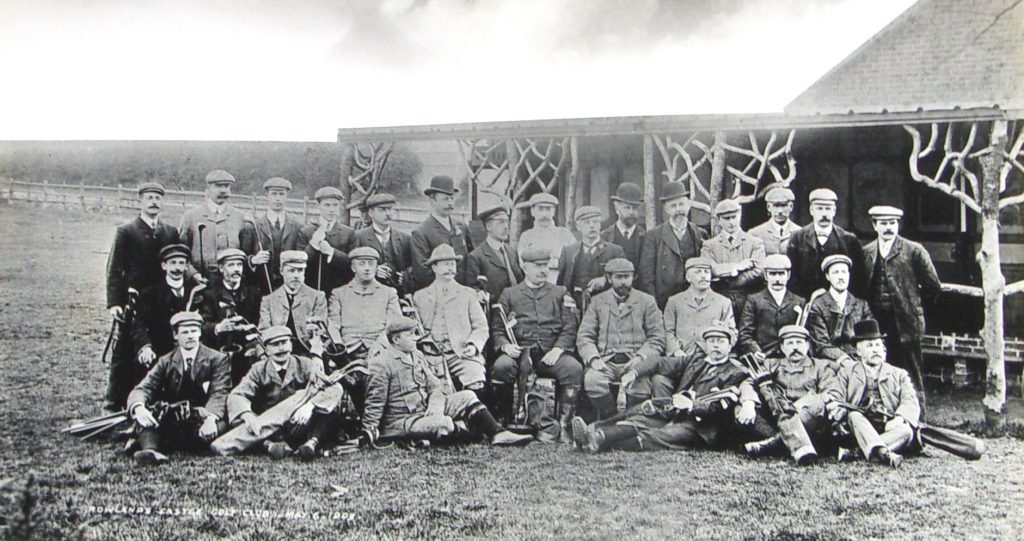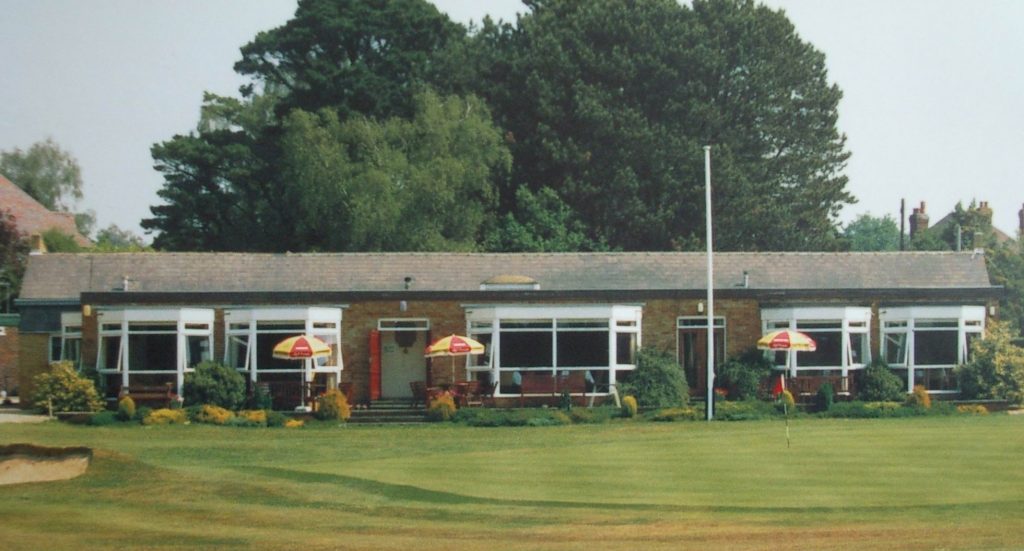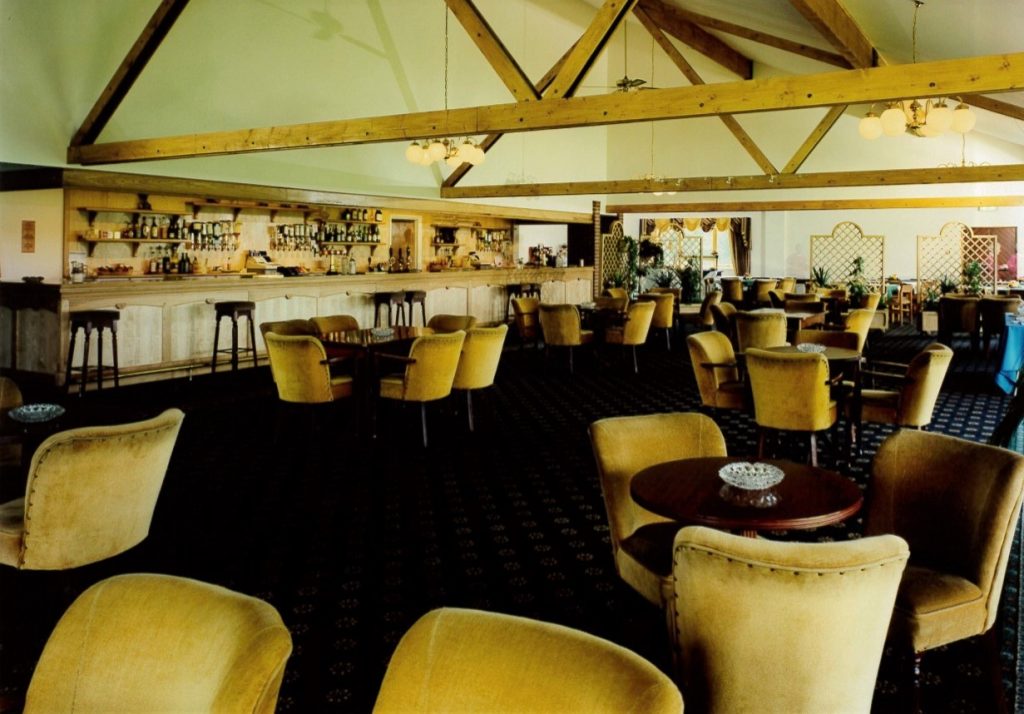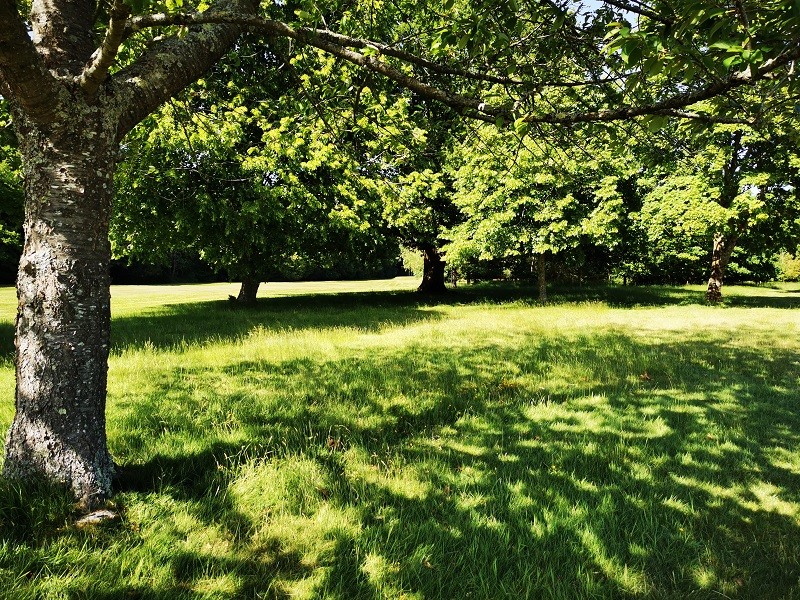Rowlands Castle Golf Club 1902 –

Current Status, Management and Organisation
Rowlands Castle Golf Club is located in Links Lane and today occupies a site of over 100 acres with the focal point being a magnificent Clubhouse that was built in 1993. It is a “members” club with the freehold and assets owned by the members who number almost 1000, comprising men, ladies, social and juniors.

The most important aspect of any golf club is the course and at RCGC we have one of the best “parkland” courses in the region. Its 18 holes measure 6642 yards from the back tees and provide a stern test of golf for even the most accomplished player, however, different tees allow for varying standards of play.
In the British climate any course needs to be able to cope with a wide range of conditions and to this end we have installed fairway watering with our own bore hole and for wetter weather we have recently had a major investment in drainage. The course was originally a 9 hole course but in 1922 was redesigned by the world famous designer, Harry Colt (designer of Wentworth, Royal Portrush and many others) and remains essentially the same today as it was then.
Another important aspect of any golf club is its retail shop/website and teaching facilities and at RCGC we have one of the most experienced golf Professionals in Hampshire. We have a very well stocked shop with prestige ranges of clubs, trolleys, shoes and clothes and an indoor teaching/club fitting studio with the latest shot monitoring equipment. In addition we have a 6 bay outdoor covered driving range for use by members.
As a members club it is guided by a series of Committees made up of elected club members who participate on topics as varied as the course, clubhouse, social and finance all of which are overseen by the Management Committee, which is headed by the elected Club Captain. The Captain is effectively the Chief Executive of the club and is elected for only one year. The Captain represents the club in numerous golf competitions throughout the year and hosts all manner of golf, social and charitable events at the club. Each year the new Captain chooses one or two charities to support. The day to day running of the club and its functioning is the responsibility of the General Manager who has a staff of around 20 people covering course maintenance, catering, bar and administration.

History
The club was founded in 1902 by a group of local businessmen who saw an opportunity to convert farmland into a golf course and set about building 9 holes without any of today’s mechanical aids – just shovels and horses and carts! There was no clubhouse to start with but a disused railway carriage was purchased in 1903 and later a “pavillion” was built to accommodate the members.

This photo of Rowlands Castle Golf pavilion was taken sometime in the early part of the last century. Note the ladies in all their splendid hats, and the young lads in the front – perhaps hoping to earn a penny or two from caddying – also all wearing some form of headgear.

As the club membership increased in the 1920s the course was extended to 18 holes, as mentioned above, and the clubhouse facilities improved. This trend continued until the start of the second world war when the club was severely impacted by the war effort. In the late 1940s the club resumed its activities but was in some financial difficulty and needed the support of many of the members to see it through and regain its momentum. With membership increasing in the 1960s another new clubhouse was built and formed the basis of today’s clubhouse which was built on top of the old one!

The club celebrated its centenary in 2002 and many events were held to commemorate the achievement culminating in a Gala Ball held on 22nd June where 430 people enjoyed jazz and dinner in a specially erected marquee.
Links & Relationships
The club is very much aware of its impact on its neighbours, whether they be the Forestry Commission, farmers or residents and at all times attempts to act as a good neighbour. The course is maintained by a team of 7 green staff and a head green keeper who get guidance from a committee elected to provide objectives and strategic direction rather than day to day support. The course is a haven for wildlife with frequent sightings of rabbits, foxes, deer and flying visits by buzzards, red kites, kestrels and pheasants. Adders are also seen in the summer, but golfers tend to keep clear!
The golf club has regular matches with local clubs across all sections of the playing membership (men, ladies, seniors and juniors). These matches are in addition to the many internal competitions that take place throughout the year. The club also has a number of “reciprocal” arrangements with other clubs which allow an exchange of players between clubs to get experience of different playing conditions. The club was recently selected to host the final of the Hampshire Professional Golfers Association end of season competition which saw 30 of the top professional golfers in Hampshire competing for the “Race to Rowlands” title. The feedback from the participants was extremely positive about the course and the club. Over the years a number of our juniors have become very talented golfers and recently one has represented England and has now progressed to the professional ranks.
Summary
We are fortunate to be sited in the middle of a large village and as such benefit from local membership as well as others from further afield. Our membership extends from very young to very old and from “scratch” golfers to absolute beginners. Our Professional runs free golf taster sessions for juniors and adults to encourage anyone thinking of taking up golf to get started.

We also have a wide range of social events to appeal to those who do not only want to play golf and the modern and spacious clubhouse can cater for social events of up to 120 people.
We regularly hold dinner/dances, themed meals, and quiz nights as well as receptions and dinners for visiting groups. If you are interested in any aspect of the club please feel free to make contact with us at the addresses and numbers below.
Editorial: This Golf Club article was written by Club Archivist Peter Deal who has been an RCGC member for the past forty years. It was first placed on the website in November 2019
Contacts:
Rowlands Castle Golf ClubLinks Lane
Rowlands Castle
PO9 6AE
Club Office 02392 412784
General Manager 02392 419151
Professional 02392 412785
The Course
Origins
Rowlands Castle Golf Club’s course was first used in 1902 and was created on about 50 acres (20 hectares) of farmland rented from Sir Henry Clarke-Jervoise, a local landowner and dignitary. The course’s 9 hole layout and design was developed by the then Hon. Secretary G. C. Vernon-Inkpen together with William Eames, the golf professional from Petersfield Golf Club. In those days creating the shape and form of the course was with manpower and horsepower, rather than machinery, and some evidence of the original works is still visible in the shape of mounds of excess earth. As today there were many ditches throughout the course and its maintenance was achieved by men with scythes and flocks of sheep!
Development
After the Great War, when the Club struggled to survive, a further 60 acres was rented from the landlord and in 1922 the course was extended to 18 holes. The new land was to the north of the original and the layout and design was created by the world renowned golf course architect, H. S. (Harry) Colt who designed many famous courses including Muirfield, Royal Portrush, Royal Troon and Wentworth. In 1963 the club purchased the freehold of the course together with additional land to the north of the existing site. During the winter of 1971/72 two new holes were created on the new land and the resulting revised layout is very much as today with 18 holes, par of 72 from the back tees and length of over 6600 yards (6km).
Current

The course today covers approximately 120 acres (48 hectares) of land bounded by Links Lane, Redhill Road and Castle Road to the east and south and by Forestry Commission land to the west with farmland to the north. Apart from the structural changes above the course has a full irrigation system covering both greens and fairways and is supplemented by a bore hole and surface storage tank. The club has invested heavily in drainage to allow winter golf to be maximised.
The clubhouse is located in Links Lane and was extended and upgraded in 1994 and provides a focal point for both golfing and social activities for members and guests alike.
Terrain
Those of you who have tried gardening in Rowlands Castle will be familiar with the quality (or lack of it) of the soil locally and you will have some idea of the challenges facing the greenkeepers. Clay, flint and chalk are the main constituents and constant work is needed to maintain the golf course in top playing condition. Many of the contract companies that have been employed to undertake major ground works have been surprised by the difficulty encountered and by the rapid wear of their machinery! One of the unusual features of the course is a line of swallow holes (a depression in the soil and chalk subsoil which erodes and collects surface water) running from the Holt in the west to Redhill in the east – the largest of the holes collects rainwater from the many ditches on the course and the water disappears underground and surfaces at Bedhampton Spring! Another feature, although not unusual, is the crossing of the course by two Public Footpaths – one running from the north of Links Lane across the course and into the forest in the west and the other from Links Lane heading south and joining Castle Road. Over the past 50 years the course has changed from being almost completely open, with views across multiple holes to one described as a parkland course with thousands of trees having been planted.
Maintenance

The upkeep of the course is in the hands of a small team, led by the Head Greenkeeper, who have a regular schedule of tasks, partly dictated by the time of year and weather conditions. They are responsible for the day to day management of the course but are assisted in terms of strategic direction by a Course Committee made up of elected Officers of the club. The normal staffing level is 7 greenkeepers with some extra temporary help at peak times and their main task is to keep the grass healthy. This may seem obvious but it entails a range of tasks including top dressing, aeration, scarifying, dew removal, feeding and irrigating to keep the playing surfaces in top condition.
Modern machinery makes these tasks somewhat easier than in the past but the demands of golfers have increased at the same time. With this in mind the Club has employed a specialised Course Architect to enhance the Course Development Plan and conduct a full survey to help modernise and redevelop the course. One of the main factors affecting all of this work will be the changes we have seen in the climate and the weather extremes of recent years.
Woodland Management

Over the years the club has planted a wide range of trees, some mistakenly, including leylandii, poplar, birch, sycamore and eucalyptus and as a result many of the mature trees found on the course today should not ideally be there! The strategy is to encourage the development of quality specimens of native broadleaved trees that add character to the course and to remove leylandii, poplars, eucalyptus and others that do not meet this policy. In doing this the club will give full consideration to the ecological implications and the presence of any protected animals or plants, including creating attractive environments for wildlife.

Periodically trees will be removed or thinned where they grow too close together or grow into the golfers shot line and in addition, the thinning or removal of scrub areas adjacent to woodland will be undertaken to help air movement and minimise disease. All major work related to woodland management, which is one of our major tasks, is conducted under the direct supervision of the Head Greenkeeper, the Course Committee and where necessary professional guidance.
Flora & Fauna

The course is located at the eastern end of a complex of woodland, heath and pasture, which was formerly the Forest of Bere. Much of the land before golf arrived was agricultural pasture and arable farmland, criss-crossed with hawthorn hedges, some of which survive today. In the “rough” areas of the course there is a rich mixture of native grasses and chalk loving plants including at least two types of wild orchid and one type of violet. To the south east of the course the old forest contains mature areas of oak, beech, yew, holly, hazel and ash. In the 1990s , together with the Forestry Commission, two large plantations of trees were planted and have today become mature wooded areas. Perhaps the highlight of the course is the carpet of bluebells which can be seen in the wooded area to the north west of the course in the spring.

One of the pleasures of playing golf is the regular sighting of local wildlife and we are fortunate in Rowlands Castle to have our fair share. Not all wildlife is a bonus, however, and the greenkeepers have a constant battle repairing rabbit holes, particularly in the rim of the bunkers and mole hills that suddenly appear in random places!

The mammals that are seen most regularly are roe deer, foxes and squirrels and in the summer we are fortunate to have reptiles in the shape of grass snakes, adders and the occasional lizard. Bird life is abundant with all the usual garden species plus regular sightings of buzzards, kestrels and more rarely, red kites.

There seems no better way to conclude this article than to use the description of the golf course coined by the Editor of the RCHC Website who called it “the green lung of the village”.
Editorial: This Golf Club article was written by Club Archivist Peter Deal who has been an RCGC member for the past forty years. The photographs are courtesy of Kevin Hensman, Head Greenkeeper, RCGC. It was first placed on the website in December 2020.